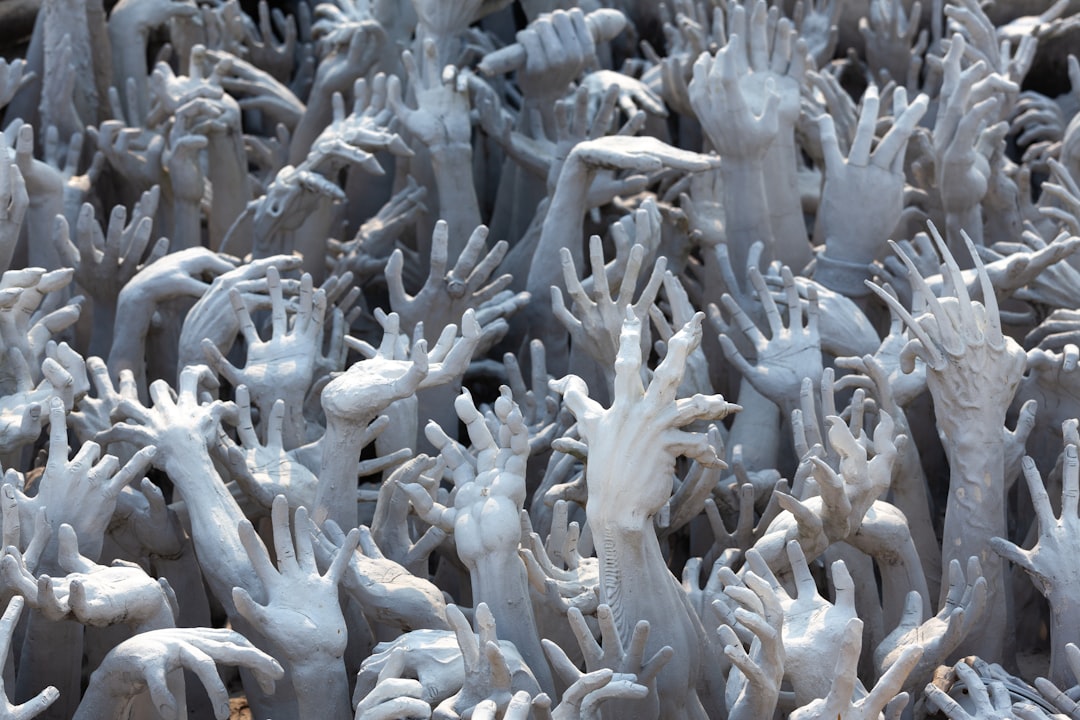The Dread
Two weeks before I became a Zen monk, I slept with my ex-boyfriend. A week after that, I punched him in the stomach. It was simultaneously intentional and involuntary. And, in retrospect, illuminating.
The day after we slept together, as I sat alone in my living room amid the half-packed boxes of books, clumps of clothes, and stacks of stuff, “The Dread” began roiling through me. Here's how I described it in my journal:
I feel like it’s going to take me over—swallow me like a black cloth covering me. I shrink and disappear. It’s so big but I can’t keep running from it. I won’t keep running from it. It starts in my solar plexus fluttering like the beat of 1,000 bats, fluttering and fluttering until it hits a fever pitch, pushes up, wraps around my heart (wings become a black snake), pulses up my throat, and locks my jaw. Eat through it, drink through it, cry it out, but it never leaves.
A week later, as my ex-boyfriend Stan (not his real name) stood in his slouchy way against a wall in my living room, a confession slipped past the tea-tree toothpick sloping from his mouth: last night he had slept with another woman. I felt The Dread storm up from my solar plexus, ricochet through my chest, before it shot down my right arm, crystallizing into a fist. A fist that punched him in the stomach. I was trembling. Stan was stunned. After a few moments, we embraced and both apologized.
The next afternoon, a hot-and-sticky June one, he saw me off. As I sat in my Nissan Maxima with my window down and the engine idling, Stan handed me a self-addressed, stamped postcard and asked me to keep in touch. He told me he was feeling anxious about my leaving and his not being able to contact me because there was no cell phone or Internet connection at the monastery. Stan was the last person I saw before I drove out of Austin and west toward the unknown.
What was a fist the day before, was now a wave.
Our tumultuous relationship was the primary reason I quit my six-figure job, abandoned my beautiful condo, folded up my life, and moved to a Zen monastery in Northern California. During the four years we were sort-of together, I did jump off our merry-go-round romance for a few weeks here and there, only to find my chagrined self sitting atop the horse of habit, as we galloped slowly in circles.
When my friends asked me why I was ditching my comfy life, platitudes slipped out of my mouth: “I need a change of pace” or “My job is sucking me dry.” I omitted the part about being plagued by The Dread. However I recall two phone conversations where a I responded candidly before my “internal editor” could intercede and prevent the confession:
“I feel like I am going to be annihilated when my romantic relationships fall apart,” I uttered into my flip phone (this was 2008).
To my surprise, neither one of them responded with a what are you talking about? tone. Instead, they both softly spoke their fears: “That's why I don't leave my husband,” my colleague revealed. My other friend, who was single at the time, quaked through the phone: “Don't laugh, but that's why I have a dog.”
Their honesty and vulnerability heartened me. Neither flinched at my use of the word “annihilate”; however, I was surprised I had used that word because until that moment, I hadn't linked The Dread with the fear of my self being annihilated.
To face The Dread, to stop running from it, to stop being bullied by it, was at the heart of my spiritual quest.
The Fist of SELF
For many of us, our first impulse, like most animals, is to avoid discomfort, deny death, and escape dissatisfaction: the suffering that the Buddha teaches is inherent in human existence. On the surface, it looks like jealousy was the reason why I punched my ex-boyfriend; however, it's more accurate to say that what threw the punch, if you will, was my inability to be present, open and stable while The Dread roiled through me. Instead I panicked and punched. Clearly, the punch was a manifestation of my suffering or dukkha (Pali).
I call this punch the “fist of SELF” where the acronym stands for: Suffering Ego Limits Freedom. The image of a fist is a helpful one because it reminds me that there is constricted and agitated psycho-emotional energy—an arising self—that needs attending to. How does a Suffering Ego Limit Freedom? The more we grasp onto transient sensory experiences—the tighter the fist is clenched—the stronger the identification is with a “me.” It's not that this “me” doesn't exist, it just does not exist as the independent, permanent self we believe it to be.
If we pay careful attention to what's happening, we'll discover that everything is always becoming. So referring to “self” as a noun, a static person or thing, might be accurate grammatically, but it does not reflect the flux that is life. I find it’s helpful to use the verb “selfing” to more accurately reflect the nano-moments of consciousness and sensory experience that we refer to as “me.” The more we can experience ourselves and life (life=us) as flowing in each moment, the less we suffer. The less the energy of life is constricted into a fist of SELF. And, while I’m introducing new words, I’d like to introduce this one: “selfing-suffering.”
The selfing-suffering process is fueled by the ancient, twisted karma we inherit from unfathomable causes and conditions: ancestral, biological, cultural, geographic, religious, etc. To oversimplify, our karmic conditioning is simultaneously the cause and the result of innumerable moments of fist clenching throughout our lives. All the moments where we were unable to stay present, open, and compassionate with arising distress, discomfort, afflictive emotions, unsatisfactoriness—you get the idea.
Clearly, punching my ex-boyfriend in the stomach was the result of my karmic conditioning and his too; otherwise he would not have been on the receiving end of my reactivity. For both of us, our unresolved negative karma limited our freedom to make skillful decisions. Karma bullied us to act and speak in ways that caused harm to ourselves and each other.
Although the content of our suffering (the “why is this happening to me”), is unique to each person, the process of selfing or ‘becoming a me” is identical in all of us—unless you’re an arahant or buddha. As Shakyamuni Buddha discovered, there’s an aspect of human consciousness that clings to or identifies with arising phenomena and makes a “me” out of these transient sensory experiences.

The Five Aggregates Affected by Clinging
One schema that the Buddha taught as a lens through which to relate to what arises through our sense organs is that of the five aggregates or skandhas in Sanskrit. Also, it’s helpful to remember that “the standard definition of the First Noble Truth is that the five aggregates affected by clinging (upādāna) are the succinct manifestation of the truth of dukkha.”1 If we "reverse" this, we could say that if the five aggregates are not clung to, then suffering is not manifested even if there's a sense of a lingering self(ing).
So the clenching of an open hand into a fist is the analogy I’ll continue to use for the process of “becoming a me.” First, “what are the five aggregates?” you ask or maybe you don’t since you are already familiar with this paradigm. Just so we’re all on the same page, though, below is a succinct description of each:
Form (rūpa)
all physical phenomena, i.e., all sentient and non-sentient beings
Feelings (vedanā)
covers feelings of pleasure, pain, and neither-pleasure-nor-pain, regardless of whether they are based on physical or mental sensations
Perceptions (saṃjñā)
denotes the mental act of applying labels or names to physical or mental events
Mental formations (saṃskāra)
covers the verbal and mental processes of concocting thoughts, questions, urges, or intentions in the mind
Consciousness (vijñāna)
covers the act of consciousness at any of the six sense doors: eyes, ears, nose, tongue, body, and intellect
These five aggregates are the main constituents of what we refer to as “me, myself, and I.” Another way to phrase it is that they comprise our personalities. Often referred to as the “self-clinging” aggregates, you’ll be happy to learn, just like I was, that the aggregates are inherently free from clinging (upādāna). Yay! This means that, as the Buddha’s enlightenment demonstrated, it’s possible to become free from or amid suffering.
One of my favorite scholar-monks is Bhikkhu Anālayo. In his invaluable book Excursions into the Thought-World of the Pāli Discourses, he delves into the sutras to discuss essential concepts of Buddhism. This is where I first heard about the “Culavedalla-sutta” which explains that it is lust or desire with regard to the five aggregates that fuels the process of clinging. When we appropriate this impersonal phenomena, e.g., “my body,” “my car,” “my mind,” we think we are in possession of and control over what arises internally and externally.
Bhikkhu Anālayo states that the when the aggregates become the objects of clinging, which is why he refers to them as “five aggregates [affected by] clinging.” He further clarifies the profound difference between the aggregates and clinging:
“Without such clinging, what is left are the bare five aggregates. The “Khānda-sutta” in the Samyutta-nikāya explains that the ‘five aggregates’ and the 'five aggregates [affected by] clinging’ cover the same ground, namely any possible instance of bodily form, feeling, perception, volitional formations and consciousness. What makes the difference between them is the presence or absence of clinging.”2
To be continued in two weeks! With my next post “Change Nothing. Be Present,” I will relate how the Venerable Pema Chodron’s profound wisdom helped me move from fist to flow. Here’s a koan that you can contemplate in the meantime: “Energy without labels is freedom.”
Thanks for reading, dear reader!
Bhikkhu Anālayo. Excursions into the Thought-World of the Pāli Discourses. Pariyatti Press, Washington, 2012.
Ibid.





This is really good Heather!! Thanks.
Great piece. Thank you!